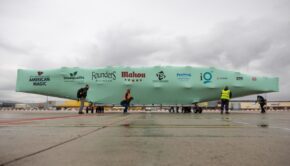Volvo Ocean Race partners with NOAA on Southern Ocean study
Published on March 20th, 2015
The teams in the 2014-15 Volvo Ocean Race are assisting in an environmental project to provide vital data from the Southern Ocean.
The U.S.-based National Oceanic and Atmospheric Administration (NOAA) collects ocean and weather data to provide mariners with accurate forecasts of seas, as well as coastal forecasts and regional climate predictions.
It takes a lot of effort to maintain these observations in all of the ocean basins to support these forecasts, and NOAA can’t do it alone.
Partnerships are critical to maintaining a network of free-floating buoys, known as drifters, and NOAA have asked the Volvo Ocean Race fleet to assist them on the forthcoming leg.
During the fifth leg of the race, the teams race from Auckland (NZL) and travel through the Southern Ocean before rounding Cape Horn and ending in Itajaí (BRA) after a 6,776-nautical mile journey.
All six of the Volvo Ocean Race teams are deploying a drifter during the fifth leg of the race, in the Southern Ocean – a region oceanographers don’t get to visit regularly, but one that is critically important to observe.
“The Southern Ocean is poorly sampled compared to other ocean basins because it is so remote from most shipping lanes where observations are collected,” said Dr. Rick Lumpkin, Director of NOAA’s Global Drifter Programme.
“However, it plays a critical climate role in the global conveyor belt circulation and links the Atlantic, Pacific and Indian Oceans, so it is extremely important to observe currents and temperatures there.”
The operations centre of the Global Drifter Programme, housed at NOAA’s Atlantic Oceanographic and Meteorological Laboratory in Miami, continuously seeks opportunities for deployments in remote.
Martin Kramp serves as the ship coordinator at JCOMMOPS, a support centre of the Joint Technical Commission for Oceanography and Marine Meteorology of World Meteorological Organization, and UNESCO’s Intergovernmental Oceanographic Commission.
JCOMMOPS monitors observing networks and helps exploit synergies in the Global Ocean Observing System, such as deployment opportunities across different programmes. Kramp helped coordinate this unique opportunity and partnership.
“Organised ocean sailing events, such as races and rallies, are a new component of growing importance in volunteer ocean observation,” explained Kramp.
“We have shown the feasibility and efficiency of such partnerships in the last months and we are very happy that the Volvo Ocean Race is collaborating with us as a part of the current race.”
Knut Frostad, CEO of the Volvo Ocean Race, said: “The oceans are our race tracks and we are delighted we can assist with the building of knowledge about them in this way.
“I look forward to following the data from the drifters that our fleet drops as they race through the Southern Ocean, passing some of the most remote locations on the planet.”
Anyone can access the drifter data at http://www.aoml.noaa.gov/phod/dac.
Each of the six racing teams are deploying their drifter at the same predetermined coordinates.
As soon as they are in the water, they will drift with ocean surface currents and transmit data on surface pressure and ocean currents through a global satellite network.
Team Alvimedica navigator Will Oxley describes the program as they deploy their drifter.
Video published on Mar 20, 2015.









 We’ll keep your information safe.
We’ll keep your information safe.